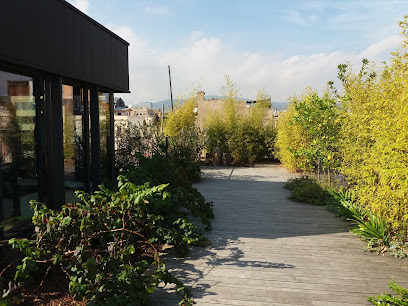In 1920 Karl Faust founded the Marimurtra botanical garden in Blanes with the aim of increasing knowledge of Mediterranean plants

Ciutat Vella
Ciutat Vella, the old town, is the historic nucleus of Barcelona and covers a small area of some 500 hectares. When you discover Ciutat Vella, you’ll discover the origins of Barcelona. Until the mid-19th century, the city was hemmed in by its medieval walls which roughly followed the Avinguda Paral·lel, Ronda de Sant Pau, Ronda de Sant Antoni, Carrer de Pelai, Passeig de Lluís Companys and Parc de la Ciutadella.
The walls were demolished in 1854, and the only surviving fragment once housed the medieval shipyards (the Drassanes, now the city’s maritime museum, the Museu Marítim) and was part of the gate known as the Portal de Santa Madrona. Ciutat Vella comprises four large districts. In the centre, is the Gothic Quarter, the oldest part of Barcelona’s urban fabric. To the east, on the other side of the Via Laietana, is the district comprising Sant Pere, Santa Caterina and La Ribera − home to the Born quarter − which is the medieval extension of the Gothic Quarter. To the west, on the other side of La Rambla, is the Raval, which originated from the rural roads outside the city walls and was the cradle of the Industrial Revolution in Spain in the 19th century. And to the south, Barceloneta, the fishing district built in the 18th century to rehouse the people from the Ribera whose homes had been demolished to make way for the military citadel.
The urban fabric of this district is irregular and random. Like a palimpsest, it has accumulated the traces of the last 2,000 years of history, from Roman Barcino, the Barchinona of the Middle Ages, to the multicultural and cutting-edge Barcelona of the 21st century. A stimulating ensemble of extraordinary landmarks and streets containing cultural, culinary and artistic attractions that you must savour at your own pace.
The neighbourhoods of the Ciutat Vella are El Raval, El Gòtic, La Barceloneta, Sant Pere, Santa Caterina i la Ribera
Source from: Barcelona Turisme
Comprehensive renovations in Barcelona, specialists in building renovations, home renovations, vertical work and general construction. We are a company created
Architectural studio that builds new penthouses on old buildings using an off-site construction system
At Total Homes we want to make the house you’ve always imagined a reality. We know that the process can
EMERGENCY PLUMBER BARCELONA Major de Sarriá 119 SPECIALITIES: PLUMBER UNBLOCKING PIPE PLUMBER TAP INSTALLER PLUMBER INSTALLER OF WATER HEATERS AND
The centre of the Roman city, today’s Gothic Quarter, was marked by the point where the two main streets, the Cardo and Decumanus, converged. Today the Carrer del Bisbe and Carrer Llibreteria stand on this site. Nearby, we can still see the remains of the Roman temple of Augustus. In fact, the original centre of Roman and medieval Barcelona still forms the core of 21st-century Barcelona. Its maze of narrow streets and squares is steeped in the city’s past and present.
Here, in the Gothic Quarter, we find the City Hall and the seat of the Catalan Government, the Palau de la Generalitat, the Cathedral and other Gothic churches, including Santa Maria del Pi and Sants Just i Pastor. Very near the Plaça de Sant Jaume, right in the middle of this Barcelona neighbourhood, is the old Jewish Quarter, the Call Jueu, with its endless narrow streets, where some remains of the ancient synagogue still survive.
In the Gothic Quarter, the Plaça del Rei proudly showcases the architectural ensemble made up of the royal residences of the Catalan-Aragonese monarchs. Below the square, you can visit the impressive archaeological remains of Roman Barcino. Behind the Cathedral stands the beautiful Plaça de Sant Felip Neri, with its baroque church. The square is surrounded by narrow streets in a Barcelona neighbourhood suffused with history which comes to life when you go there.
Source: Barcelona Turisme
Barcelona’s Raval neighbourhood, which was hemmed in by the city walls until 1859, is now bounded by La Rambla, Carrer Pelai, the Ronda Sant Antoni, Ronda Sant Pere and the Paral·lel. These ancient Roman roads marked out the boundaries of the walls which were demolished so that the rapidly growing city could expand.
Within these perimeters, this area, which had been the site of fields and convents until the mid-19th century, saw the construction of textile mills and workers’ houses throughout the network of narrow winding streets in this Barcelona neighbourhood. As a result of its industrialisation and proximity to the port, the Raval became a neighbourhood with a high immigrant population, where social problems were commonplace. And it was because of this that the journalist Àngel Marsà christened it the Barrio Chino in 1925, a monicker still used until fairly recently.
The efforts made by Barcelona City Council since the 1990s to clean up and improve living conditions in Raval neighbourhood, by building new streets, such as the Rambla del Raval, and creating institutions which have had a major impact on its social and cultural life, such as the Centre de Cultura Contemporània and MACBA (Museu d’Art Contemporani de Barcelona), have given the Raval back its reputation and prestige.
Source: Barcelona Turisme
The Barceloneta is a triangular spit of land that cuts into the sea boats in the old harbour, or Barcelona’s Port Vell, on one side, and sandy beaches on the other. The neighbourhood, with its narrow, rectilinear streets, was built on a military grid structure to provide accommodation for the former inhabitants of La Ribera who had lost their homes due to the construction of the citadel. The houses were low-rise and small in scale so as not to obstruct views of the city.
The Barceloneta was once the home of fishermen, people associated with the fishing trade and the metal industry, and is now one of the city’s most visited and popular districts. In 1988, in pre-Olympic days, the decision was taken to demolish the old beachfront restaurants, known as xiringuitos, and public baths, heralding a process of opening the city up to the sea and the modernisation of an area which now offers first-class beaches as the main attraction for its visitors.
On the sand and inside the neighbourhood, rows of restaurants and bars combine with the traditional images of locals sitting in their chairs in the street and narrow balconies displaying clothes drying in the sun.
Source: Barcelona Turisme
Barcelona’s Via Laietana, which was built during the first half of the 20th century to link up the Eixample with the port, opened up a new route for traffic while slicing up the old town into different sections.
Santa Caterina and Sant Pere neighbourhood were densely populated and built-up neighbourhoods at the time, with an industrial tradition that strongly defined their personalities. Indeed, the first textile mills of Barcelona, the heirs to the neighbourhood’s craft tradition, set up premises here throughout the 18th century. As a result, the Santa Caterina and Sant Pere neighbourhood became an over-populated, working-class district with poor living conditions.
Over the years, Barcelona’s municipal policy of urban redevelopment and improvement schemes has contributed to cleaning up the area and providing it with renovated facilities such as the Santa Caterina Market, which was restored by the architectural practice of Enric Miralles and Benedetta Tagliabue. The presence of the modernista jewel and World Heritage Site, the Palau de la Música Catalana, in the neighbourhood of Sant Pere, certainly confirms the interest of this zone. The legacy of the Romanesque monastery of Sant Pere de les Puelles and the main streets with their shops, also captivate curious visitors who walk through what was the first district of medieval Barcelona.
Source: Barcelona Turisme
Ciutat Vella Barcelona | Ciutat Vella | Shopping in Ciutat Vella | What to do in Ciutat Vella | Where to go Ciutat Vella | What to visit Ciutat Vella | What to see Ciutat Vella | Where to eat Ciutat Vella | Where to stay Ciutat Vella | Where to Shop | Dining in Ciutat Vella | Eating out in Ciutat Vella | Takeout Ciutat Vella | Sports Ciutat Vella | Events in Ciutat Vella | What’s on in Ciutat Vella | Shows in Ciutat Vella | Parks in Ciutat Vella | Restaurant in Ciutat Vella | Pubs in Ciutat Vella | Supermarket in Ciutat Vella | Club in Ciutat Vella | Book store in Ciutat Vella | Hair salon in Ciutat Vella | Hair & Beauty Ciutat Vella | Nail salon Ciutat Vella | Barber Ciutat Vella | Banks in Ciutat Vella | Clothes shops in Ciutat Vella | Toy shop in Ciutat Vella | Fashion shopping Ciutat Vella | Where to go Ciutat Vella | What to visit Ciutat Vella | What to see Ciutat Vella | Where to eat in Ciutat Vella | find and book your hotel | book a table at your chosen restaurants in Ciutat Vella Barcelona | Where to stay Ciutat Vella | Hotels Ciutat Vella | property rentals Ciutat Vella | B&B Ciutat Vella Barcelona | Where to Shop in Ciutat Vella | Dining in Ciutat Vella | Eating out in Ciutat Vella | Takeouts Ciutat Vella Luxury dining Ciutat Vella | Sports shops Ciutat Vella | Events in Ciutat Vella | What’s on in Ciutat Vella | Shows in Ciutat Vella | Parks in Ciutat Vella | Restaurant in Ciutat Vella | Pubs in Ciutat Vella | Supermarket in Ciutat Vella | find International supermarkets | visit the famous mediterranean supermarket, | Clubs in Ciutat Vella | Book store in Ciutat Vella | Hair salon in Ciutat Vella | Hair & Beauty Ciutat Vella | Nail salon Ciutat Vella | Barber Ciutat Vella | Banks in Ciutat Vella | Clothes shops in Ciutat Vella | Toy shop in Ciutat Vella | Property for sale Ciutat Vella Barcelona | Apartments for sale Ciutat Vella Barcelona | luxury property for sale | Ciutat Vella Barcelona | property rentals Ciutat Vella Barcelona | find oversee property for sale | Mediterranean property agents Barcelona | Recommended Restaurants Ciutat Vella | Cafes Ciutat Vella | Asian restaurants Ciutat Vella | Spanish Restaurants Ciutat Vella | Italian Restaurants Ciutat Vella |



